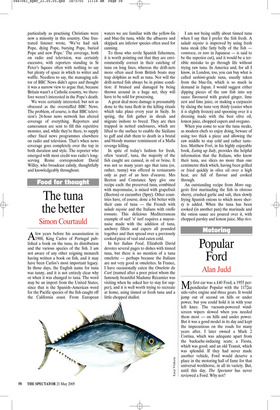Popular Ford
Alan Judd
My first car was a £40 Ford, a 1955 perpendicular Popular with the 1172cc side-valve engine and three gears. It would jump out of second on hills or under power, but you could hold it in with your left knee. The vacuum-powered windscreen wipers slowed when you needed them most — on hills and under power. But it was a good model in its day and kept the impecunious on the roads for many years after. I later owned a Mark 2 Cortina, which was adequate apart from the backache-inducing seats; a Fiesta, which was good; and an old Transit, which was splendid. If they had never made another vehicle, Ford would deserve a place in the motoring hall of fame for that universal workhorse, in all its variety. But, until this day, The Spectator has never reviewed a Ford. Why not? My own record shows I’m not against them. I even wrote a book about a man called Ford (albeit one who never drove and was no relation to Henry). Nor is there any evidence that Spectator readers disdain the products of the Ford Motor Company; it’s likely that a significant number own them. And we have reviewed plenty of other mass-market models — Fiats, Renaults, Toyotas, Hondas, VWs, and so on. Is it a question of perception: might I have thought that Spectator readers would think that Fords are — in that vanishing phrase — Non-U?
Many Spectator readers are well heeled, most are choosy and some own exotic sets of wheels. Rightly or wrongly, it’s easy to assume that they prefer to read about smarter, more expensive cars such as Lexus, Mercedes, BMW, Audi, Range Rover, Jaguar or Bentley. In other words, aspirational cars, which Ford’s are not.
Ford is the victim of its own success. It produced the world’s first true mass-market car, the Model T, and time and again through the rest of the 20th century it came up with innovative, trend-setting market leaders. You have to have been there to appreciate how revolutionary the Mark 1 Cortina seemed in this country, compared with its 1962 rivals. Fords were reasonably priced and cheap to maintain; as the car-buying public increased, more and more bought them. But less so wealthier drivers, who went for more expensive cars thought (not always rightly) to be more solid, longer lasting and classier (and which then included Rover, R.I.P., but no Japanese). As car buyers became not only more numerous but also generally much richer, so more of them began to aspire to the more exclusive marques. Those whose parents might once have considered a Ford Consul or Granada went for the BMW 5 Series or Mercedes E Class. Then cheap money meant that the much larger number of those who couldn’t quite afford the aspirationals suddenly felt as if they could.
The result is that Ford’s £1.84 billion profit last year put it at number six in the unofficial world ranking for car-makers, way behind Toyota’s winning £5.88 billion, although comfortingly ahead of that other underperforming giant, 11th-placed VW (£485 million). Given the scale and spread of Ford’s operation, it should be at least on a par with number two, Nissan (£2.55 billion). Especially as it is making some of the world’s best-value cars.
The Focus, for example, has sold four million since 1998, helped by rave reviews of its dynamic qualities, class-topping customer-satisfaction surveys and a reputation as Europe’s best mid-range family car. The hatchback is reckoned superior to the Golf, the estate is said to rival the smaller Audis and Volvos. New model prices start at £10,895, but I had the range-topping £18,525 TDCi estate, powered by a twolitre 136bhp Titanium diesel, which yields 51.4mpg on the combined cycle and has a maximum speed of 125mph.
It’s a good-looker, elegantly tapered at the rear, with a roomy, high-quality interior and a well-made feel. Excellent visibility makes for easy parking, and ride and handling are so good that you don’t notice them unless you make a point of it. They’re built in Germany and Spain, and servicing is annual or every 12,500 miles. At the end of the week, I had to scratch my head for niggles, but a sunny day did produce one: in the right wrong conditions, there’s a fair bit of dashboard glare (as with Volvos). But that wouldn’t stop me buying one.
Like its predecessor, this car will deservedly sell well. Whether it will raise Ford’s market profile for those aspiring to high automotive status is more doubtful, because for many people a Ford is a Ford is a Ford and those who aspire to Jaguars, Land Rovers, Volvos or even Aston Martins will continue to do so. Yet, whether or not they realise it, they’ll still be buying Fords, and each of those Fordowned marques is all the better for it. Ford’s strategy for coping with its perception problem — if you can’t beat ’em, buy ’em — may have been costly but in the long run it’s masterly. It means that many more Spectator readers than realise it are already Fordians.


























































 Previous page
Previous page